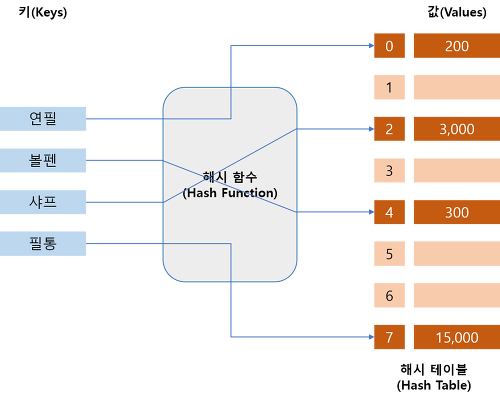
📒 해쉬 테이블(Hash Table)
- Hash Table? 키(Key)에 데이터(Value)를 저장하는 데이터 구조
- Key를 통해 데이터를 바로 받아올 수 있음 → 속도가 획기적으로 빨라짐
- 파이썬 딕셔너리(Dictionary) 타입이 해쉬 테이블의 예 - Key를 가지고 바로 데이터(Value)를 꺼냄
- 보통 배열로 미리 Hash Table 사이즈만큼 생성 후 사용(공간과 탐색 시간을 맞바꾸는 기법)
- 파이썬에서는 해쉬를 별도로 구현할 필요 없음 - 딕셔너리 타입을 사용하면 되기 때문

이미지 출처 : https://dev-kani.tistory.com/1
✅ 해쉬 테이블 용어
- 해쉬(Hash) : 임의 값을 고정 길이로 변환하는 것
- 해쉬 테이블(Hash Table) : 키값의 연산에 의해 직접 접근이 가능한 데이터 구조
- 해싱 함수(Hashing Function) : Key에 대해 산술 연산을 이용해 데이터 위치를 찾을 수 있는 함수
- 해쉬 값(Hash Value) 또는 해쉬 주소(Hash Address) : Key를 해싱 함수로 연산해서 해쉬 값을 알아내고, 이를 기반으로 해쉬 테이블에서 해당 Key에 대한 데이터 위치를 일관성 있게 찾을 수 있음
- 슬롯(Slot) : 한 개의 데이터를 저장할 수 있는 공간
- 저장할 데이터에 대해 Key를 추출할 수 있는 별도 함수도 존재할 수 있음
✅ 간단한 해쉬 테이블 만들기
📢 hash table 만들기
hash_table = list([i for i in range(10)])
print(hash_table) # [0, 1, 2, 3, 4, 5, 6, 7, 8, 9]list comprehension
[출력표현식 for 요소 in 입력 Sequence [if 조건식]]
- 입력 Sequence는 Iteration이 가능한 데이터 Sequence 혹은 컬렉션
- [if 조건식]에서 []는 리스트 괄호가 아니라 옵션이라는 뜻, 즉 조건이 있을 때만 넣으면 된다는 뜻임
# list comprehension 예시
# 위 코드의 출력표현식을 i에서 i*i로 바꾼 결과
hash_table = list([i*i for i in range(10)])
print(hash_table) # [0, 1, 4, 9, 16, 25, 36, 49, 64, 81]
# 종류가 다른 데이터에서 정수 리스트만 가져오기
dataset = [False, 49, "seunghye", 31.43, 6, 10]
int_data = [num for num in dataset if type(num)==int]
print(int_data) # [49, 6, 10]📢 간단한 해쉬 함수 만들기
- 다양한 해쉬 함수 고안 기법 중, 가장 간단한 방식은 Division 법(나누기를 통한 나머지 값을 사용하는 기법)
def hash_func(key):
return key % 5📢 해쉬 테이블에 저장하기
- 데이터에 따라 필요시 key 생성 방법 정의가 필요함
data1 = 'seunghye'
data2 = 'lee'
data3 = 'biscoff'
data4 = 'Lotus'
## ord(): 문자의 ASCII(아스키)코드 리턴
print(ord(data1[0]), ord(data2[0]), ord(data3[0])) # 115 108 98
print(ord(data1[0]), hash_func(ord(data1[0]))) # 115 0
print(ord(data1[0]), ord(data4[0])) # 115 76📢 해쉬 테이블 값 저장 예시
- data : value와 같이 data와 value를 넣으면, 해당 data에 대한 key를 찾아서, 해당 key에 대응하는 해쉬주소에 value를 저장하는 예
def storage_data(data, value):
key = ord(data[0])
hash_address = hash_func(key)
hash_table[hash_address] = value
storage_data('seunghye', '01043809999')
storage_data('cy', '01045006622')📢 데이터 읽어보기
def get_data(data):
key = ord(data[0])
hash_address = hash_func(key)
print(hash_table[hash_address])
get_data('seunghye') # 01043809999✅ 해쉬 테이블 장단점
- 장점
- 데이터 저장/읽기 속도가 빠름(검색 속도가 빠름)
- 해쉬는 키에 대한 데이터가 있는지(중복) 확인이 쉬움
- 단점
- 일반적으로 저장공간이 좀 더 많이 필요함
- 여러 키에 해당하는 주소가 동일할 경우, 충동을 해결하기 위한 별도 자료구조가 핊요함
- 주요 용도
- 검색이 많이 필요한 경우
- 저장, 삭제, 읽기가 빈번한 겨웅
- 캐쉬 구현시(중복 확인이 쉽기 때문)
✅ 해쉬 테이블 시간 복잡도
- 일반적인 경우(Collision이 없는 경우)는
O(1) - 최악의 경우(Collision이 모두 발생하는 경우)는
O(n)
✅ 프로그래밍 연습
💻 연습1: 리스트 변수를 활용해서 해쉬 테이블 구현해보기
- 해쉬 함수 : key ^% 8
- 해쉬 키 생성 : hash(data)
hash_table = list([0 for i in range(8)])
print(hash_table) # [0, 0, 0, 0, 0, 0, 0, 0]
def get_key(data):
return hash(data)
get_key('seunghye') # 5687436291790947533
def hash_func(key):
return key % 8
def save_data(data, value):
hash_address = hash_func(get_key(data))
hash_table[hash_address] = value
def read_data(data):
hash_address = hash_func(get_key(data))
print(hash_address)
print(hash_table[hash_address])
save_data('seunghye', '01043005555')
save_data('cy', '01045778844')
read_data('seunghye') # 2 # 01043005555
read_data('cy') # 0 # 01045778844
print(hash_table) ['01045778844', 0, '01043005555', 0, 0, 0, 0, 0]💻 연습2 : 연습1의 해쉬 테이블 코드에 Chaining 기법으로 충돌해결 코드 추가해보기

Chaining 방식은 Linked List를 이용하는 방법으로 저장하려는 해시테이블에 이미 같은 키값의 데이터가 있다면, 노드를 추가하여 다음 노드를 가르키는 방식으로 구현하는 것
hash_table = list([0 for i in range(8)])
print(hash_table) # [0, 0, 0, 0, 0, 0, 0, 0]
def get_key(data):
return hash(data)
def hash_func(key):
return key % 8
def save_data(data, value):
index_key = get_key(data) # index_key 추가
hash_address = hash_func(index_key) # 해싱 함수에 index_key 대입
if hash_table[hash_address] != 0: # 해쉬 테이블에 데이터가 차 있으면
for index in range(len(hash_table[hash_address])):
if hash_table[hash_address][index][0] == index_key:
hash_table[hash_address][index][1] = value
return
hash_table[hash_address].append([index_key], value)
else:
hash_table[hash_address] = [[index_key, value]]
def read_data(data):
index_key = get_key(data)
hash_address = hash_func(index_key)
if hash_table[hash_address] != 0:
for index in range(len(hash_table[hash_address])):
if hash_table[hash_address][index][0] == index_key:
print(hash_table[hash_address][index][1])
return None
else:
return None
save_data('sh','01043885555')
save_data('st','01044998855')
save_data('sn','01033226666')
print(hash_table) #
[
0,
[[-7316118316409785375, '01043885555'], [-2016450872523258815, '01033226666']], << 충돌된 부분 chaining 처리
0,
[[-6747111481167668693, '01044998855']],
0,
0,
0,
0
]- Linear Probling, sha256 해쉬 알고리즘 등 구현해보기(추가예정)
👩💻 참고 링크
- https://www.fun-coding.org/Chapter09-hashtable-live.html
- https://dev-kani.tistory.com/1
- https://en.wikipedia.org/wiki/Hash_table
- https://bcho.tistory.com/1072
- http://egloos.zum.com/sweeper/v/925740
